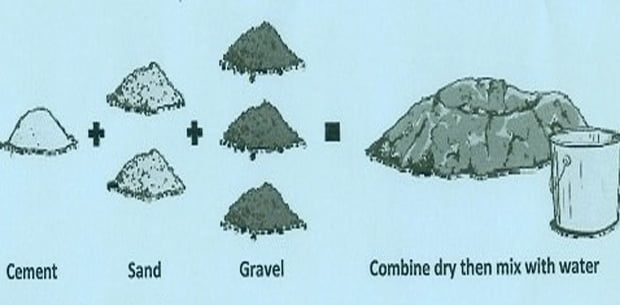Types Of Concrete Grade Mix Ratio and Their Uses

Types Of Concrete Grade Mix Ratio and Their Uses
The concept of concrete grade mix ratio is a system of practice by different countries that enable them to know the proportion of cement in ratio to fine and Coarse aggregates to enable them determine a nominal compressive strength of concrete with respect to their environment within a given time period mostly at 28days of curing.
In Nigeria, serious effort of work and contribution is current going on in different areas of our engineering field that will ensure we have our own Nigerian code of practice that will meet international system of operations.
 The purpose of our discussion today is to use the British standard of practice to explain the types of concrete grade that we mostly use for our local construction works, their mix ratio and the nature of jobs that we can apply this concrete grade to during construction works.
The purpose of our discussion today is to use the British standard of practice to explain the types of concrete grade that we mostly use for our local construction works, their mix ratio and the nature of jobs that we can apply this concrete grade to during construction works.
Firstly, it is important we understand some frequently used term as we progress in our discussion about the types of concrete mix ratio and their application to our building jobs.
NORMINAL MIX CONCRETE:
This simply refer to the preparation of concrete mix that can be done by volume to determine the compressive strength of the concrete at 28days of curing. it is mostly used for construction works that does not required higher concrete strength.
COMPRESIVE STRENGTH OF CONCRETE:
This is the maximum amount of strength a concrete cube measuring 150mm by 150mm by 150mm develop after 28 days to resist the crushing force or axial force on it before reaching it failure point during a compressive test analysis.
CHARACTERISTICS SRENGTH OF CONCRETE:
This is the average value of different compressive strength result below which not more than 5% of the samples are expected to fail during a concrete test analysis.
CONCRETE GRAGE:
This could be referred to has the outcome of a numerical value that correspond to the compressive strength of concrete with respect to their mix ratio at 28 days of curing period.
We have different types of concrete grades starting from the nominal to standard concrete grade followed by the higher level concrete grade. for the purpose of our discussion we will subject ourself to the nominal grades of concrete.
The nominal grades of concrete are as follows C10, C15 and C20. where C implies the concrete mix and the numerical value 10 represent the compressive strength develop at crunching after 28 days of curing.
MIX RATIO OF CONCRETE:
The mix ratio of concrete is the proportion by volume of cement, sand and coarse aggregate that is needed to produce a nominal concrete grade in the presence of adequate water.
The mix ratio helps to determine different strength of concrete grade depending on the proportion at which they are combine together.
Now that we understand these basic terms, it will now be easier to explain the nominal concrete grades that will be needed to carry out our local construction jobs at site.
These grades of concrete are all nominal grades of concrete and they are suitable for construction works that does not required too much of high concrete grade in other wards for simple site construction works.
For those construction jobs that require higher concrete grade, it is always better to use either the standard grade of concrete or the design mix in other to arrive at the required concrete grade for the job.
For a low-quality job, a mix ratio of 1:3:6 will produces a compressive concrete strength of 10N/mm2 when subjected to axial crunching force at 28days of curing.
The grade of concrete for this type of mix ratio is known to be C10, Where “ C ” stand for the concrete mix and 10 stand for the numerical compressive strength value at 28days of curing.
This grade of concrete can be used for low construction jobs that does not require higher level of load that can cause damage to the concrete.
it can be used for Plain cement concrete (PCC )flooring, patio making, walkways, but it is cannot be used for structural works such as foundation works, columns works, slab works and beam construction works.
For a better-quality job at site a mix ratio of 1:2:4 will produces a compressive strength of 15N/mm2 when subjected to a crunching force at 28days period of curing.
This grades of concrete for this type of mix ratio by volume is known to be C15, where “C” represent the concrete mix and 15 represent the numerical value of the compressive strength of concrete at 28days of curing. This concrete grade can be used for pavement making, pack flooring for garage, blinding works.

For structural jobs at the site a mix ratio of 1:1.5:3 will produce a compressive strength of 20N/mm2 when subjected to a crunching force at 28days of curing.
This grade of concrete for this type of mix ratio is known to be C20, where c is referred to as the concrete mix and 20 represent the numerical value of the compressive strength develop at 28 days of curing.
This concrete grade is suitable for reinforce concrete like slab works, columns works, beam works etc. The grade C25 can be used for foundation works and footing columns works.
There are other concrete grades that are used for structural works where high concrete strength is required, this grade includes C25, C30, C35 to C70 but since our focus is limited to only nominal grade of concrete, it will be unwise to discuss in details about these concrete grade.
Thank you so much for reading this article to the end i hope it will help you in your site activities works. happy learning.






[…] this blog post, we’ll look at why cracks happen in concrete, the different types of cracks you might see, and how to repair them. You’ll also learn some […]